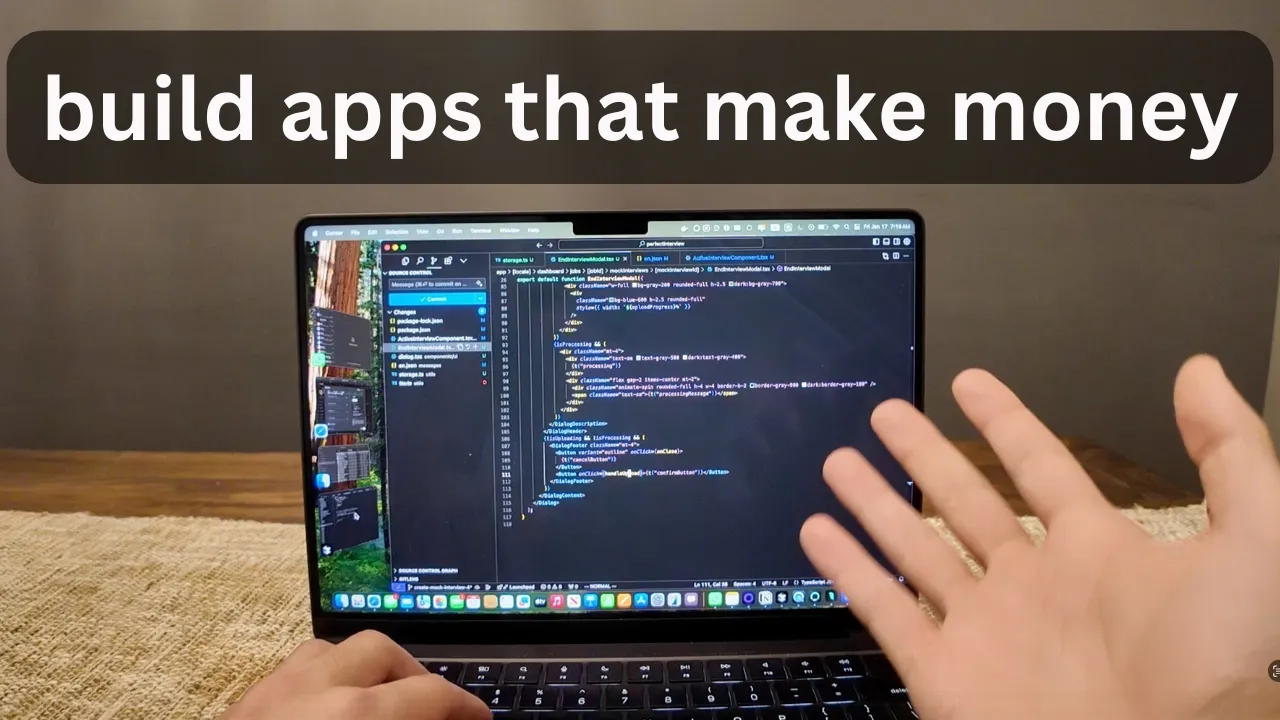
Breaking into the app market as a solo developer can seem daunting, but with the right approach, you can build profitable applications that generate real income. In this comprehensive guide, I'll share the exact process for taking an app from concept to cash-generating product, based on real-world experience of building multiple successful applications that generate thousands in monthly recurring revenue.
Step 1: Coming Up With a Profitable App Idea
The first hurdle most solo developers face is coming up with a viable app idea. Here's the truth that most won't tell you: you don't need to invent something revolutionary. In fact, one of the most reliable paths to success is building on proven concepts.

When it comes to app ideas, forget originality and focus on validation. The most successful approach for solo developers is to identify apps that are already making money and build your own version with slight improvements. This strategy eliminates the risk of building something nobody wants.
Why Copying Existing Ideas Works
Many new developers get hung up on creating something completely original, but this is actually counterproductive when you're just starting out. Here's why copying existing successful apps is smart:
- The market has already been validated by others
- You can see exactly what features users are willing to pay for
- You can study existing marketing strategies that work
- You can differentiate your product over time after establishing a revenue base
Think about it like opening a restaurant. McDonald's existing doesn't mean you can't open a burger joint. Similarly, software markets can support multiple solutions to the same problem. My own AI meeting recording tool, which now generates thousands in monthly revenue, started as a variation of existing tools before I added unique features that differentiated it.
How to Find App Ideas Worth Building
To find profitable app ideas, pay attention to what's being marketed to you across platforms like Twitter, Reddit, Instagram, and YouTube. Look for apps that are actively advertising—this indicates they're making enough money to justify marketing spend. These are the markets worth entering.
- Monitor social media for apps with active advertising campaigns
- Look for problems mentioned repeatedly in professional communities
- Notice which apps your colleagues or industry peers are paying for
- Research trending topics in tech communities and forums
Step 2: Building Your App with the Right Tech Stack
Once you have your idea, the next challenge is choosing the right technologies to build it. As a solo developer, your focus should be on speed, simplicity, and community support—not chasing the latest trending framework.

Web Application Development
For web applications, prioritize frameworks with large developer communities over niche technologies. This ensures you'll have plenty of resources and support when you inevitably run into problems.
- Framework: Next.js is currently the most widely-used and well-supported full-stack framework
- Hosting: Vercel provides the simplest deployment path for Next.js applications
- Backend: Supabase offers authentication, database, and storage solutions in one platform
While there are endless debates about the "best" framework, Next.js offers the perfect balance of popularity, documentation, and community support. This means when you encounter issues, solutions are readily available—even AI coding assistants are better trained on popular frameworks.
Mobile Application Development
If you're building a mobile app, cross-platform solutions will maximize your efficiency as a solo developer:
- Framework: Expo (based on React Native) for building iOS and Android apps with a single codebase
- Native Development: Only consider Swift (iOS) or Kotlin (Android) if your app is platform-specific
- Backend: Use the same Supabase backend to maintain consistency across platforms
The key is avoiding analysis paralysis. Many solo developers waste months debating technology choices instead of building. Pick a mainstream stack with good documentation and start coding—you can always refine your architecture later once you're generating revenue.
Payment Processing
For monetizing your app, simplicity is crucial:
- Stripe remains the gold standard for payment processing with excellent documentation
- Implement subscription payments for recurring revenue
- Start with simple pricing tiers before experimenting with complex models
// Example of implementing Stripe checkout in Next.js
import { loadStripe } from '@stripe/stripe-js';
const stripePromise = loadStripe('your_publishable_key');
const handleSubscription = async () => {
const stripe = await stripePromise;
const { error } = await stripe.redirectToCheckout({
lineItems: [{ price: 'price_id', quantity: 1 }],
mode: 'subscription',
successUrl: 'https://yourapp.com/success',
cancelUrl: 'https://yourapp.com/cancel',
});
};Step 3: Marketing Your App to Generate Revenue
Building your app is only half the battle. The difference between apps that make money and those that don't often comes down to marketing execution. As a solo developer, you need efficient marketing strategies that don't require massive resources.

Leveraging Communities and Platforms
The most effective marketing channels for solo developers are often free or low-cost community platforms where your target users already gather:
- Product Hunt for initial launch exposure
- Reddit communities related to your app's niche
- Twitter/X for building in public and connecting with potential users
- Specialized forums and Slack/Discord communities in your target industry
- Creating content that demonstrates your app solving specific problems
The key is to approach these platforms with a value-first mindset. Don't just promote your app—demonstrate how it solves real problems for users in these communities. Share your journey, insights, and the specific use cases that make your app valuable.
App Store Optimization (ASO)
If you're building a mobile app, optimizing your presence on app stores is crucial:
- Research keywords that your target users are searching for
- Create compelling screenshots that clearly demonstrate value
- Write benefit-focused descriptions that address user pain points
- Encourage satisfied users to leave positive reviews
- Continuously update your app to maintain visibility in search results
Building a Simple Marketing Funnel
Even as a solo developer, you need a basic marketing funnel to convert interested visitors into paying customers:
- Create a landing page that clearly communicates your app's value proposition
- Offer a free tier or trial to reduce friction for new users
- Implement email capture to nurture leads who aren't ready to purchase
- Use targeted content to address specific use cases and pain points
- Leverage testimonials and case studies once you have successful users
Common Pitfalls Solo Developers Should Avoid
After building multiple apps, I've identified several common mistakes that prevent solo developers from monetizing their work effectively:
- Perfectionism: Endlessly polishing features instead of launching
- Overcomplicating: Adding too many features before validating core value
- Underpricing: Charging too little out of insecurity about your product
- Poor positioning: Failing to clearly communicate who your app is for and what problem it solves
- Ignoring analytics: Not tracking how users interact with your app
- Tech obsession: Focusing on technical details instead of user needs
The Solo Developer's Roadmap to Profitable Apps
Based on my experience building multiple revenue-generating apps, here's a practical roadmap for solo developers looking to create profitable applications:
- Find an existing app category with proven market demand
- Build an MVP using mainstream technologies with good community support
- Launch quickly, even if your initial version is basic
- Charge money from day one to validate willingness to pay
- Gather feedback from early users to guide improvements
- Incrementally add features that differentiate your app
- Scale marketing efforts based on channels that show traction
- Optimize your pricing as you better understand user value
The most important insight is that making money from apps isn't about creating something revolutionary—it's about executing well on proven ideas and continuously improving based on user feedback. Start by copying what works, then differentiate over time as you build a revenue base.
Conclusion: Taking Action as a Solo Developer
Building profitable apps as a solo developer is absolutely achievable in today's market. The key is focusing on execution rather than originality, using proven technologies rather than chasing trends, and marketing effectively to your target audience.
Remember that your first app doesn't need to be perfect—it just needs to solve a real problem for users willing to pay. Start with a validated idea, build it using mainstream technologies, and focus on getting it in front of potential customers as quickly as possible. The path to generating your first dollar from an app is more accessible than ever for solo developers willing to take action.
Let's Watch!
Solo Developer's Guide: How to Build and Monetize Apps That Actually Make Money
Ready to enhance your neural network?
Access our quantum knowledge cores and upgrade your programming abilities.
Initialize Training Sequence